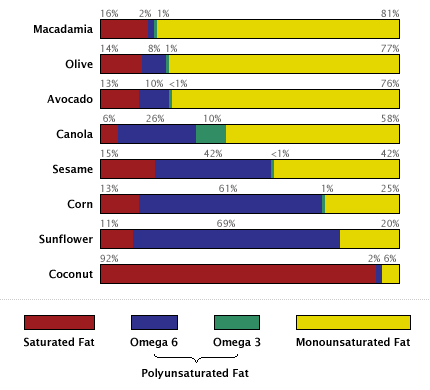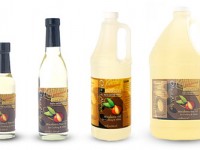My cooking revolves around the “healthy trinity” of lean proteins, friendly fats, and good carbohydrates. It may be hard to imagine how these abstractions translate into real food, but I assure you that my refrigerator is full (too full, according to my husband) of tasty incarnations.
Fats
Fats constitute the most basic building block for healthy cooking because they so often support the other two. Consequently, I put them at the center of the trinity and the beginning of this discussion.
Our bodies need fat for all sorts of processes and structures, but we can be picky about the
types of fat we put into them. With respect to sources, my favorites are avocadoes, nuts, and olives, which are high in monounsaturated fats—as well as oily fish, such as salmon, with high omega-3 content. For actual cooking (as opposed to flavoring), I rely exclusively on two kinds of oil: olive and macadamia nut. The health benefits of olive oil are widely known and there is no need to repeat them here. I use it wherever its distinctive flavor is an asset. It is absolutely essential in Italian cooking and all Mediterranean cuisines, and I also use it in many Mexican, Cuban, and Caribbean dishes. I’m sure that you own at least one bottle of it, and that you know how it behaves and what it can do.
Macadamia Nut Oil, on the other hand, is a secret. Among culinary oils, it is the highest (even higher than olive oil) in beneficial monounsaturated fats and the lowest (even lower than olive oil) in omega-6 fats, which have been associated with cancer and cardiovascular disease.
Comparison of Dietary Fats and Oils

Although it lacks the hydroxytyrosol of olive oil, it’s the best choice when an olive flavor would be inappropriate or intrusive. (Hydroxytyrosol is a phytochemical and powerful anti-oxidant in olive oil that appears to have aspirin-like effects.) Macadamia nut oil has an ultra-mild flavor and a high smoke point. I substitute it for canola, peanut, vegetable, safflower, sunflower, and grapeseed in recipes that call for a neutral oil. I’ve tested it in Indian, Thai, Vietnamese, Korean, Chinese, Japanese, Mexican, and Caribbean dishes with consistently excellent results. It’s perfect for stir-frying and for high-temperature roasting. Finally, macadamia nut oil offers a wonderful opportunity to “buy American” and support our own growers: Hawaii produces the best in the world!
The virtues of these two great oils are undeniable. And yet, too much of a good thing is, well, not so good. Fat—even the best kind-- contains 9 calories per gram as opposed to carbohydrate and protein, which weigh in at 4. So, if you’re trying to control your caloric intake, limiting fat is a good place to start. However, because fat intensifies and conveys flavor in food, it is as indispensable in healthy cooking as in the conventional kind. I just try to be judicious about its use.
Regarding trans and saturated fats, the former have no place in a healthy diet and the latter should be minimized. Although not all saturated fats are created equal, certain ones really are worth avoiding. For example, palmitic acid (found in meat and dairy as well as some plants) increases levels of “bad” cholesterol (LDL) and then teams up with it to create conditions inside blood vessels that lead to arterial damage and cardiovascular disease. In addition, recent animal studies suggest that it may interfere with hormonal control of our sense of fullness so that we eat more than we should. Since we can’t tell the good from the bad and the ugly in animal fat, it’s best to eliminate it where we can. I use only small quantities of full fat dairy products and I’m an indefatigable trimmer of poultry and meat. If you want to know what I mean by “indefatigable”, watch the videos entitled
Chicken Liposuction 1&2 and
Pork Surgery.
Carbohydrates
As mentioned
elsewhere, I have been influenced by the Zone Diet, but I’m no longer a strict adherent. One remnant of my former allegiance, however, is my respect for the concepts of glycemic index (GI) and glycemic load (GL). These parameters are used to characterize the impact of carbohydrates on blood sugar levels. A calorie may be a calorie, but-- in my experience-- people tend to feel hungrier and eat more overall when they consume large quantities of high-glycemic carbohydrates. In addition, high-GI carbs may increase “sweet-tooth” type cravings. This may not be true of everyone (and you’re lucky if it’s not true of you), but it does make an enormous difference in some people—and I am one of them. As a result, I focus on low-GI carbohydrates (i.e. most fruits and vegetables). Although I do use some high-GI foods (including conventional sweeteners), I either combine them with low-GI ingredients (e.g. beets with beet greens, corn with black beans) or use them in small quantities. Both strategies lower the glycemic load of a given meal. High-GI ingredients are never the primary component of any dish.
Because so much information is available online, I will not go into detail about the glycemic index and glycemic load, but will merely point you in the right direction.
Wikipedia presents a nice overview of the topic
http://en.wikipedia.org/wiki/Glycemic_index , as well as a solid discussion of glycemic load
http://en.wikipedia.org/wiki/Glycemic_load . On the more practical side, you will find a database at
http://www.glycemicindex.com within which you can find the GI of many foods. Armed with this information, you can conduct your own experiments and decide for yourself whether it is worth considering the GI or GL in your meal planning.
Before going on to proteins, I’d like to make one thing clear: I am NOT advocating a “low-carb” regimen. What I do advocate is
informed carbohydrate (and protein and fat) consumption in quantities that suit your genetic makeup and activity level. I don’t measure carbohydrates, but—based on what I know—I’d estimate my daily intake at around 130 g. No one would consider that “low-carb”.
Proteins
I use 2 classes of proteins in my cooking: those that are inherently lean or high in omega-3 fats and those that can be
made leaner. The first category includes soy protein (e.g. tofu), egg whites, low-fat dairy products, all seafood, the skinless white meat of poultry, the leanest cuts of pork, beef, lamb, and veal (e.g. tenderloin), as well as bison (a.k.a. buffalo), and venison. (I do not include beans in this group because the cellulose matrix that dominates their structure raises questions about how much of their protein is actually absorbed.) The latter category includes meats and poultry that can be nutritionally improved through skinning (e.g. duck breasts and chicken thighs) and meticulous trimming, or whose fat-contribution to a recipe can be reduced effectively through secondary techniques such as
Degreasing Liquids. (Even a flat-cut brisket can sneak into this category.) Certain proteins, such as pork and beef tenderloins, straddle both categories because they're the leanest cuts of a particular type of meat
and they can be trimmed (see
Pork Surgery) to make them even leaner. Occasionally, I use small quantities of high fat meat products such as bacon, but I view them as flavorings that add fat, rather than sources of protein.
 Although it lacks the hydroxytyrosol of olive oil, it’s the best choice when an olive flavor would be inappropriate or intrusive. (Hydroxytyrosol is a phytochemical and powerful anti-oxidant in olive oil that appears to have aspirin-like effects.) Macadamia nut oil has an ultra-mild flavor and a high smoke point. I substitute it for canola, peanut, vegetable, safflower, sunflower, and grapeseed in recipes that call for a neutral oil. I’ve tested it in Indian, Thai, Vietnamese, Korean, Chinese, Japanese, Mexican, and Caribbean dishes with consistently excellent results. It’s perfect for stir-frying and for high-temperature roasting. Finally, macadamia nut oil offers a wonderful opportunity to “buy American” and support our own growers: Hawaii produces the best in the world!
The virtues of these two great oils are undeniable. And yet, too much of a good thing is, well, not so good. Fat—even the best kind-- contains 9 calories per gram as opposed to carbohydrate and protein, which weigh in at 4. So, if you’re trying to control your caloric intake, limiting fat is a good place to start. However, because fat intensifies and conveys flavor in food, it is as indispensable in healthy cooking as in the conventional kind. I just try to be judicious about its use.
Regarding trans and saturated fats, the former have no place in a healthy diet and the latter should be minimized. Although not all saturated fats are created equal, certain ones really are worth avoiding. For example, palmitic acid (found in meat and dairy as well as some plants) increases levels of “bad” cholesterol (LDL) and then teams up with it to create conditions inside blood vessels that lead to arterial damage and cardiovascular disease. In addition, recent animal studies suggest that it may interfere with hormonal control of our sense of fullness so that we eat more than we should. Since we can’t tell the good from the bad and the ugly in animal fat, it’s best to eliminate it where we can. I use only small quantities of full fat dairy products and I’m an indefatigable trimmer of poultry and meat. If you want to know what I mean by “indefatigable”, watch the videos entitled Chicken Liposuction 1&2 and Pork Surgery.
Although it lacks the hydroxytyrosol of olive oil, it’s the best choice when an olive flavor would be inappropriate or intrusive. (Hydroxytyrosol is a phytochemical and powerful anti-oxidant in olive oil that appears to have aspirin-like effects.) Macadamia nut oil has an ultra-mild flavor and a high smoke point. I substitute it for canola, peanut, vegetable, safflower, sunflower, and grapeseed in recipes that call for a neutral oil. I’ve tested it in Indian, Thai, Vietnamese, Korean, Chinese, Japanese, Mexican, and Caribbean dishes with consistently excellent results. It’s perfect for stir-frying and for high-temperature roasting. Finally, macadamia nut oil offers a wonderful opportunity to “buy American” and support our own growers: Hawaii produces the best in the world!
The virtues of these two great oils are undeniable. And yet, too much of a good thing is, well, not so good. Fat—even the best kind-- contains 9 calories per gram as opposed to carbohydrate and protein, which weigh in at 4. So, if you’re trying to control your caloric intake, limiting fat is a good place to start. However, because fat intensifies and conveys flavor in food, it is as indispensable in healthy cooking as in the conventional kind. I just try to be judicious about its use.
Regarding trans and saturated fats, the former have no place in a healthy diet and the latter should be minimized. Although not all saturated fats are created equal, certain ones really are worth avoiding. For example, palmitic acid (found in meat and dairy as well as some plants) increases levels of “bad” cholesterol (LDL) and then teams up with it to create conditions inside blood vessels that lead to arterial damage and cardiovascular disease. In addition, recent animal studies suggest that it may interfere with hormonal control of our sense of fullness so that we eat more than we should. Since we can’t tell the good from the bad and the ugly in animal fat, it’s best to eliminate it where we can. I use only small quantities of full fat dairy products and I’m an indefatigable trimmer of poultry and meat. If you want to know what I mean by “indefatigable”, watch the videos entitled Chicken Liposuction 1&2 and Pork Surgery.
 Multimedia
Multimedia



 Follow Me on Twitter
Follow Me on Twitter Become a Fan on Facebook
Become a Fan on Facebook